by Coffee Kevin | Jan 25, 2015 |
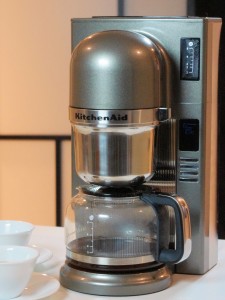 KitchenAid’s new 8-cup automatic drip Coffeemaker is proof that appliance manufacturers now take coffee making parameters as seriously as they do any culinary art. KitchenAid has long been a coffee innovator, with high build quality and within reasonable price points. This new model has literally been years in the making.
KitchenAid’s new 8-cup automatic drip Coffeemaker is proof that appliance manufacturers now take coffee making parameters as seriously as they do any culinary art. KitchenAid has long been a coffee innovator, with high build quality and within reasonable price points. This new model has literally been years in the making.
I visited them during summer 2012, during which time their four person design team held a therapy session, where I lay back and told them everything missing from most coffeemakers. Just kidding about that part, but suffice it to say, I left feeling unburdened and they went to work building it.
Sure enough, they brought it to this year’s CoffeeCon San Francisco and Los Angeles events. I recall making a beeline to taste a cup. It was good enough that I requested a model for my long-term at-home tests, from which I made review judgments.
This KitchenAid model has several important features:
• Pre-infusion stage. It dribbles a small amount of water, pauses to allow ultra fresh coffee grounds to get wet and exhale their carbon dioxide.
• Intermittent brewing throughout the brewing process, just like you instinctively do using a manual drip coffeemaker. We’ll talk more about this in in a moment.
• Two brewing temperatures. A higher one is just over 200°F, and optimized for lighter roasted (most Third Wave) coffees. The second, lower temperature setting stays under 200°F and is optimized for darker roast coffees. It’s up to you of course, as it’s so cutting edge that there’s hardly consensus on this subject. Suffice it to say, it’s amazing to see a big brand acknowledging the standards and then going a step further by offering you a choice of two brewing temperatures within those standards. Again, this is sophistication on par with manual brewing geeks.
• Perhaps the biggest news is that the KitchenAid meets SCAA (Specialty Coffee Association of America) brewing guidelines, which are stringent. This means a temperature spec (range: 196°-2015°F), within the given drip time spec of 4-6 minutes.
• Cup number setting. This at least promises to be an attempt to prefigure brewing algorithms so you and I don’t have to. More later, but this just might be their most important feature – if it does what it I think it promises.
First, let’s get this out of the way at the start – most so-called automatic drip brewers are one size brewers that are, by modern standards, not very automatic. If you make a full batch, they do well, maybe even very good, but most coffee enthusiasts eventually discover a manual coffee maker makes better coffee, since you have to figure out each parameter. But still, there’s a need for an automatic maker, because everyone, myself included has something else to do other than make coffee. It’s easy to operate. Just choose your cup setting. I had to get used to it, but the first thing you must do is select your desired cup batch size, but pressing plus/minus buttons. Then press whether you want light or dark roast (higher or lower brew temperature). Then hit brew and you’re ready in ten minutes, no matter what batch size.
How did it do in my tests?
Pre-infusion – The KitchenAid does really do this, but it’s still a best guess. As everyone who brews with manual drip brewers knows, this time varies depending upon how fresh your coffee is. KitchenAid designers chose a reasonable pause. It won’t please everyone, but in my tests, it did a good job of allowing most grounds to rise and fall, and then repeating this drip, pause, drip sequence throughout. Only at the 8-cup setting using extremely fresh roasted and freshly ground coffee did I get any foaming that left residue at the top of the brew basket (near showerhead). Most times it was not a problem.
Intermittent brewing – Part of the benefit of continuing to drip, pause and drip throughout the brewing is let all the water drip through before pouring more water onto the grounds. It seems to achieve a better, more thorough extraction. The KitchenAid did not disappoint. I’m sure there are some that will say their manual drip pours are better still, but for many, this brewer will deliver everything they want from their coffee.
Brewing temperature – Here KitchenAid has done itself proud. Its brewing temperature stability is as good or better than most manual drip, especially if you’re using a traditional kettle. If you’re using a kettle with settable temperature, the KitchenAid still matches or exceeds it, but the difference might be unnoticeable. Still, kudos for the two temperature choices and stability.
Cup setting – Many don’t realize that every automatic drip coffeemaker is optimized in contact time for one size batch. Larger batches will take too long, resulting in bitterness/excess strength; smaller batches mean faster (too fast) contact times and resulting weaker brew. This is simple math. If you baked a half batch of cookies and shortened or lengthened baking times, you wouldn’t expect them to taste right, would you? All drip makers, even manual ones have this challenge. KitchenAid seems to do some adjusting of the drip rate inside to accommodate the changing times, so it lessens it. I’d say they’ve make it work overall. The batches I made between four and eight cups were all between four and six minutes in overall contact time (this spec does not/should not count the time the water is heating with no contact). At the two cup setting, the contact time was not long enough. Keep in mind the cup quality may vary between 4 and 6 minutes contact time, but overall I was satisfied.
There are little tweaks you can try such as grinding a notch finer for fewer cups, or simply upping your grounds to water ratios a gram or two. I’ll leave it to others to explore these options. I settled on 6 cups for most of my tests over a month’s use and found it delivered excellent coffee at all settings between 5 and 8 cups, coffee on par overall with my manual drip brewers.
A couple of extra notations:
• The KitchenAid coffeemaker’s sound is quieter than most other automatic drip coffeemakers and its sound is subjectively nicer.
• KitchenAid is to be commended for offering detailed grounds to cup measuring recipes in their well-written instruction book.
• The water input at the KitchenAid’s top is too narrow for my tastes. I occasionally spilled water while filling it. Maybe it’s just me.
• I routinely filled the water tank exactly to the intended batch cups mark, and found the resulting brew on the carafe at brewing’s end was frequently less. I realize this may be caused by steam loss, but I found it works better to always overfill above the water mark.
Here are a few taste test highlights: I was fortunate to pick up a sample of Martin Diedrich’s Kean Coffee at CoffeeCon L.A. It was a slightly darker roast than most Third Wave roasts, and, (gasp) in my opinion, the better for it. It really shined, especially with using the lower (but still SCAA-approved) temperature setting. This kind of coffee really has that chocolate taste (cliché though it seems) and that temperature just seemed to highlight it.
Another treat was Counter Culture’s latest Ethoipian in a new package. This one really called for the higher temperature, but fully matched my expectations, with a fruitiness and acidity this coffee brewer brought forth in all its glory.
A surprise hit of CoffeeCon LA’s roasts was Temple Coffee’s Panama Geisha. Oh my Lord! What a coffee!! I did two batches concurrently. It was so good I went past my limit. The high temperature was my preference, but it did splendidly (albeit differently) in each. Note: I found a perfect formula for me was to make six cups, using 50 weighed grams of beans, medium-fine grind. The slightly less than full batch allowed even the freshest coffees to brew properly, and gave us a perfect way for Pat, I and a friend each have a couple of cups each.
The KitchenAid 8-cup is highly recommended.
by Coffee Kevin | Jan 2, 2015 |
 I realize this article will be read mostly by coffee enthusiasts already so involved in brewing that they likely have their own views regarding brewing, and its three most important variables: time, temperature and grind particle size. But, lately there’s been dissention over what for many years appeared to be consensus among the trade. As brewing as an art and craft (hence my book’s title) has developed, there are those who question the basics.
I realize this article will be read mostly by coffee enthusiasts already so involved in brewing that they likely have their own views regarding brewing, and its three most important variables: time, temperature and grind particle size. But, lately there’s been dissention over what for many years appeared to be consensus among the trade. As brewing as an art and craft (hence my book’s title) has developed, there are those who question the basics.
Questioning the basics is, I think, a good thing. Anyone who’s been in family counseling knows it’s a healthy thing to revisit how you divide labor. When it comes to processes, it’s a good thing to reconsider the variables. My observation is that coffee brewing is still being analyzed. Don’t forget that as roasts, types of beans, brewing methods and consumer tastes change, it’s a good idea to do a few experiments. If they confirm the basic parameters, so be it. But, they may not, and why keep doing something wrong?
Historically, much coffee was boiled. I can think of all kinds of reasons for this: pre-chlorination food safety, ease – the bubbles tell you the water’s ready, and thrift – the cheapest way to maximize extraction strength is to use the highest temperature.
The Coffee Development Group, or was it the Pan-American Coffee Council – some predecessor to the Specialty Coffee Association of America (SCAA), did extensive testing, using food experts, not just coffee folks, which resulted in the standards that have been in place for many years.
They include:
• Grind size specifications, basically finer for short extraction times, coarser for longer ones. The current challenge with enthusiasts likely to grind at home, is how to confirm this. It used to be written right on a coffee can.
• Brewing Temperature – It’s easy to tell consumers: “Under Boiling”. Everyone seems to get that now. The last percolator I came in contact was in my late Aunt’s estate sale. BTW, 195°-205°F just tightened to 196°-205°. The extra degree may or may not matter to you, but according to my little birds, the US and European specialty coffee groups wanted to share the same standards for a variety of reasons.
• Contact time – In my observation, this is the one most difficult to control, partly because it’s so difficult to measure, especially in intermittent drip methods. Ever tried?
Recently, I’ve run into a number of enthusiasts, baristas, brewer designers, who complain like music composition students do about tonal scales. Recently, I was sitting in the office of one of the most influential big-coffee business owners, who many would say personifies the word establishment and he told me he believes 200°F is too high a brewing temperature. I’m sympathetic. After all, what kind of thinker would I be if I didn’t like to challenge rules? “Question Authority” – That’s my bumper sticker!
But, I’m here to re-commit CoffeeCompanion to following the rules, at least for now. We need some kind of reference point, or a dialogue is useless. The fact is that a great number of culinary experts were consulted in creating the standards. These folks had taste buds. This wasn’t a casual industry lock down for convenience.
I will always challenge the established rules. I will also follow the standards and use them for my tests. I may expand my tests in certain instances but I will always strive to identify those instances.
Meanwhile, I urge those of you who are doing your own home experiments, playing with brewing parameters to customize your methods to your individual tastes, a worthy pursuit even within the parameters, to start off following the standards. If you decide your Chemex or Aeropress tastes milder, better straight (minus cream or sweetener) when brewed at 180°F, no one is going to take the children from your home.
But, as my music theory teacher said to us in college, “Learn the rules so they can be broken by design, not ignorance.”
We are living in a golden age of brewing. There are all kinds of new brewers, the re-discovery of old ones. The profession of barista confirms that the industry gets that how its coffee is created in a coffee establishment makes a difference. Remember: Wine tastings don’t need bartenders, but coffee tastings need baristas.
CoffeeCon, my ‘lil ol’ coffee show is great fun, but I have an agenda as plain as Karl Marx at a school board meeting. I want consumers to discover coffee as a culinary art and invest the same passion they do into cooking into brewing their coffee. Anyone can do a coffee tasting. We are a coffee university.
So, just FYI, I will keep taking any coffeemaker’s temperature, use a stopwatch to check how long it subjects your (ever-increasing-in-cost) ground coffee to hot water, and play with grind and include those results in my reports.
by Coffee Kevin | Nov 27, 2014 |
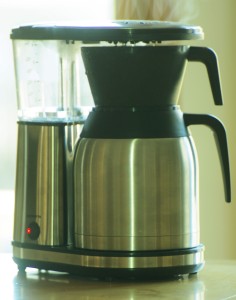
Several years ago, I was attending an SCAA event. Nancy Bloostein, of Oren’s Daily Roast nudged me and suggested I take a look at some new Melitta coffee makers. I ran (literally) over to see what appeared to be Technivorm knock-offs. They were labeled Melitta, but I was then told that they would appear on the marketplace soon under a new name, Bonavita. According to what I was told, Melitta licenses their nameplate to Hamilton Beach in the US. Therefore, although these were Melitta conceived and designed, no mention of Melitta would appear in the US market brewers.
Fast forward to 2014, Bonavita is now a treasured brand. What seems a simple proposition to make an excellent brewer priced to the average consumer, has long eluded most appliance brands. Even though it seems simple, apparently it is not. You need a smart design, one that gets the water almost-instantly hot, a spray heat that evenly disperses that hot water over the grounds, achieving even distribution, and gets the grounds thoroughly soaked, and gets all this done, start-to-finish, within 6 minutes.
So revolutionary was the Bonavita concept that it currently is the leading automatic drip coffeemaker. Bunn, Technivorm, Bodum, KitchenAid and Behmor all have fairly comparable brewers that compete, but somehow the Bonavita just seems to have an edge, when it comes to hitting the consumer sweet spot of price, performance, quality and ease. Remember if it isn’t easy, it isn’t automatic, is it?
So far, I’ve compared the Bonavita only to other automatic drip brewers. But as Third Wave Coffee has emerged, the bar has been lifted, as more consumers who use a Chemex, Hario or other manual brewer for their weekend or other special brews, want an automatic drip brewer to reach higher to match these inherently customized devices.
One interesting change: Bonavita has moved from the Melitta V-filter to the US-cupcake filter. Does this mean that Melitta no longer designs this brewer? Inquiring minds ponder this. Although I have found differences such as filter types to generally be outweighed by other factors, I philosophically agree with the reasoning that the cupcake filter spreads the grounds extraction task more evenly at the bottom, so I consider it a good (if shocking) move. I also applaud their resistance of the metal filter, which I consider overall inferior to paper in its ability to separate flavor compounds from grounds.
There are two things the Bonavita did not do as compared to manual drip. One is vary the brewing temperature. The other is match the intermittent pour that we use when we brew manually, which is especially important near the brew’s beginning when using fresh roasted coffee.
The new Bonavita offers only one brewing temperature, but they have gone out of their way to include a pre-infusion stage, which sprinkles ideally hot water over the grounds, then shuts down in order to allow a freshly-roasted, freshly-ground coffee to rise and fall appropriately, before continuously running hot water over the grounds.
So, how does it perform?
The new Bonavita handily meets every specification of an automatic drip coffeemaker, as did its predecessor. The brewing temperature is within the 196-205°F range. The brewing cycle (without pre infusion) is under 6 minutes. Pre-infusion adds around 30 seconds, as it should.
The ability to match intermittent brewing with your (or your barista’s) best efforts keeping pace with the water’s drip rate during brewing is not able to track as well as manual brewing, in my opinion the goal. Nor is it with the Behmor Brazen or any other yet-invented automatic brewer. What I can say, is I never had an overflow, no matter how fresh the grounds. I inserted a Chemex underneath the Bonavita, which is to be fair, not anything they suggest or offer to accommodate. The brew drip rate was simply too fast, even in the pre-infusion setting. But, this is more about how fast consumer expectations are rising, than any shortcoming on this brewer’s part.
What’s left? Well, the Behmor Brazen offers adjustable brewing temperatures and adjustable pre-infusion time settings. Will this matter to you? I cannot answer that, but I can say the Bonavita does a very, acceptable job with several coffees I’ve been using since it arrived one month ago.
Temple Roasters Panama Don Pepe Boquete Geisha is a light roasted delicate coffee that showed its full colors when brewed in the Bonavita. I was able to closely match what I could achieve in a Chemex.
Kean Coffee’s Nicaragua La Prometido is roasted slightly darker, or is it just the Diedrich roasting imprint? Not sure, but this stellar varietal comes through with its notes intact. This kind of roast is not for the timid (roaster that is). To catch it just before it starts to go caramel on us, is really a test of roasting skill. I was able to taste the full resolution of the coffee with the Bonavita.
Conclusion: The Bonavita took a good idea and made it better. There is not one thing I noted where I said, “Oh, I wish they hadn’t changed that”. Bravo!
by Coffee Kevin | Sep 9, 2014 |
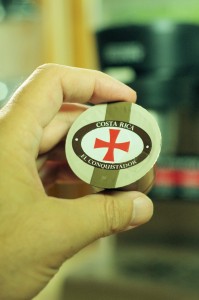 Recently, I reviewed every brewing format in the U.S. I freely admit I was previously strongly biased against pods in general and specifically the K-Cup, the number one pod format. My reasons weren’t simple connoisseur snobbery, but cool analysis based upon the following industry givens:
Recently, I reviewed every brewing format in the U.S. I freely admit I was previously strongly biased against pods in general and specifically the K-Cup, the number one pod format. My reasons weren’t simple connoisseur snobbery, but cool analysis based upon the following industry givens:
- Coffee must be brewed within two weeks from roasting.
- Drip coffee must be brewed over four-to-six minutes.
- Small batch, top-end roasted coffee isn’t available in K-cups.
Oh, and don’t forget this one:
- Anything too popular has to be bad.
With me so far? Good. Now, a few things happened since then to open my mind to at least the possibility that K-Cups might be a viable format. First, there is the Bunn My Café machine. In my tests this one machine was heads above the others in its ability to extract coffee. Keep in mind that for years Bunn has specialized in three-minute extraction through its almost-power-washing sprayhead design in traditional drip machines. The My Café gets the water up to industry-standard temperature heights and somehow (I’m not yet able to see into the brewing chamber) this results in a much better-than-average cup.
Second, the K-Cup patent expired. This means machinery entrepreneurs will be exploiting the format, perhaps even beyond what Bunn’s done (Bunn’s was developed through licensing prior to the expiration). The patent’s lapse also means a wider variety of coffee brands will be free to flood the market with K-Cups.
Third, new smaller-run K-Cup packaging machines have emerged to make it cost-effective for local roasters to make their own K-Cups. This has caused a virtual explosion. While some specialty roasters are still keeping their distance, several have announced top quality coffees in K-Cups to the general public. This brings us the likelihood of neighborhood, fresh coffee.
Last but not least, there are new in-cup technologies. In some ways these are the hardest to understand, much less describe. Boyd Coffee introduced a new K-Cup of their own design at the 2014 SCAA Conference. Even with all the coffee samples I’d had that day, the Boyd’s design was night and day better than I’d previously tasted. Boyd’s has a new type of bottom to its pod that is closer to a traditional filter. While it seems like it would undermine the already-short contact time between hot water and ground coffee, it clearly resulted in a more thorough extraction.
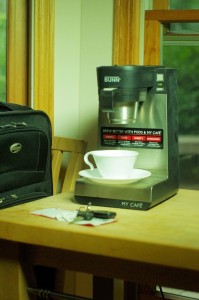
This travel photo shows why this pods are important to good coffee.
I finally tasted close to coffee nirvana later at that same event when I had a La Minita K-Cup. This design, as explained by CEO Bill McAlpin, utilizes material obtained from the surgical profession that is both slow to release but allows greater transfer of flavor oils, thus coming closest yet to what the industry calls “Gold Cup” standards.
I realize McAlpin’s coffees are already pinnacle specialty coffees that score in the 90s among coffee reviewers, but this cup truly floored me. McAlpin, more than anyone else I’ve met, convinced me he truly understands the entire process. His K-Cup’s design takes full advantage of every second of contact time inside the K-Cup (something under one minute!) and then that special material at the K-Cup’s bottom makes sure the coffee essence exits the cup in its full glory and into your cup.
McAlpin claims he’s done blind tests among the top roasters and they are unable to distinguish between their roasts brewed using a traditional drip brewer versus the same coffee prepackaged in his K-Cups! I can only underscore that I believe this might be possible using this technology and a top quality K-Cup brewer!!!
I’m sure that some jaws will drop after reading this last paragraph and my having written it. My position is I try very hard to be a coffee objectivist in what surely must be understood to be a largely subjectivist world.
I am certainly not urging anyone to discard their Chemex, Hario or French press makers for K-Cups, nor for that matter their Technivorm, Bonavita or Behmor traditional automatic drip machines. What I am suggesting is to consider what this offers in terms of consumer choices and the possibility of getting a good-to-near-great cup of coffee fully automatically and conveniently. Even I must have an option for those times in my life where the process is not the goal, but a necessity of my real goal: getting a savory cup of coffee. Such times are quick morning starts, mornings when I am heading to an airport for an early flight. Sometimes a friend drops by and we want to share the coffee, but not the time it takes to make it the manual multiple step way.
Let’s remain open minded. Let’s also retain a healthy dose of skepticism. I am simply declaring that it’s now been proven to me that it IS possible to get a very good cup of coffee with a pod machine. Once it is POSSIBLE, it’s just a question of determining how it was done, then doing it that way. Remember, The Coffee Companion’s mission is great coffee, not labor, nor for that matter technology. Stay tuned!
by Coffee Kevin | Aug 25, 2014 |
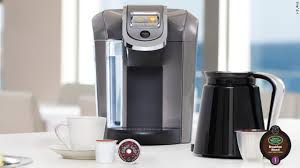
As I write this, the next generation Keurig machine is moments away from hitting American consumers. Keurig is doing everything to get the word out. I’ve had a sneak preview here and there, places such as SCAA’s recent Conference and the International Housewares Show, where prototypes were on display. I will disclose that they’ve even brought me out here to Los Angeles to witness their opening night amidst a hand-selected group. To their credit, Keurig has not attempted to influence my view of the machine, which I have not of course, had enough experience with to review. I’m to offer tasting notes on some of their blends and discuss food pairing, Actually, it’s refreshing to see a coffee maker manufacturer start off high be discussing both their machine and coffee, but of course this is a benefit of Keurig’s and Green Mountain’s marriage, a company large and sophisticated enough to really understand both the hardware and software aspects of their product.
The Keurig 2.0 has several interesting aspects. Most amazing is its ability to accommodate both the K-Cup and Vue pods. This is fortunate because the Vue was Keurig’s attempt to put forth an improved K-Cup that might appeal to high-end Third Wave coffee holdouts. It held more coffee grounds and used a different piercing technology to introduce water to the pod, with the result of more thoroughly extracting the coffee flavor. It failed as a standalone product only because it caused market confusion. Potential Vue customers had last minute sales resistance about getting hardware that offered fewer software choices. That killed it for many, many enough that Keurig withdrew the Vue this past year.
The Keurig 2.0 employs a complex mechanism to allow their new 2.0 to use both K-Cups and Vue pods. This also offers the public who did invest in Vue hope that their format will continue to be supported. I’m hopeful that 2.0 will retain the Vue’s improved brewing temperature range.
Even more profound for consumers will be the 2.0’s offering an even larger batch size. Keurig realizes that the brewing public wants 1 to 4 cups, and they’ve done that. I viewed their approach and new pod sizes last night and I suspect this will really be well received. Flexibility, with none of the down sides to compromise taste, nor having to figure anything out.
My hobby is brewing coffee, but I’m enough of a realist to know that this is simply not true for most people. They simply want a good cup, quickly, with knowledge equivalent with their other consumer needs. The Keurig 2.0 appears to solve several needs for them. For many coffee drinkers, this introduction is exciting news.
 KitchenAid’s new 8-cup automatic drip Coffeemaker is proof that appliance manufacturers now take coffee making parameters as seriously as they do any culinary art. KitchenAid has long been a coffee innovator, with high build quality and within reasonable price points. This new model has literally been years in the making.
KitchenAid’s new 8-cup automatic drip Coffeemaker is proof that appliance manufacturers now take coffee making parameters as seriously as they do any culinary art. KitchenAid has long been a coffee innovator, with high build quality and within reasonable price points. This new model has literally been years in the making.





